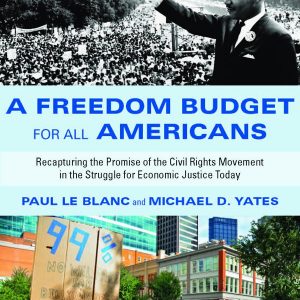BOOK REVIEW/Seth Sandronsky
Freedom Then and Now
What do we know about recent progressive reform in the US? Paul Le Blanc and Michael D. Yates have answers for the current moment in A Freedom Budget for All Americans: Recapturing the Promise of the Civil Rights Movement in the Struggle for Economic Justice Today (Monthly Review Press, 2013).
The authors take a critical look at the Freedom Budget of 1966. If this is new to you, read on.
The Freedom Budget was “a practical step-by-step plan for wiping out poverty in America during the next 10 years.” Since private business was not up to the task, government spending would bridge the gap.
Recall Uncle Sam’s role in saving the economy from the depths of the global Great Depression. Increased government expenditures stimulated private enterprise to hire and invest, following ideas of John Maynard Keynes, an influential British economist, and backer of the capitalist economy.
Later, the Marshall Plan’s economic stimulus through public spending rebuilt the private economies of Europe and Japan after WW II. Business boomed for US-based corporations.
It is useful to think of the Freedom Budget of 1966 as a Marshall Plan for the US The authors analyze the document’s rise and demise without rose-tinted glasses, capturing the arc of the left’s future collapse.
What does this all this matter now? Le Blanc and Yates write about the Freedom Budget in the face of austerity, government spending cuts as capital’s share of growth spikes.
Vitally, the Freedom Budget arose not from the powerful, but due to the blood, sweat, and tears of ordinary people. They confronted the status quo in the South and North, risking life and limb, during the Civil Rights Movement, to overthrow legal segregation.
In a careful analysis, the authors highlight the methods and meanings, people, politics and economics of the fight for black people’s civil rights. Its main target was what historian David R. Roediger calls “race-making,” legal mistreatment of black Americans, i.e., Jim Crow laws and practices.
Le Blanc and Yates conceptualize this oppressive process on two levels. One is individual, and the other is institutional.
We know that the sung and unsung freedom fighters pushing for racial justice in the 1950s and 1960s won amazing victories. How they did this, bus boycotts and other grassroots mobilizing, matters in 2013.
Behind the scenes and onstage, civil rights and anti-war actors and factors clashed and cooperated. With energy from socialist ideas and groups, civil rights activists rallied to the Freedom Budget to expand rights to all citizens for jobs, shelter and more…

Comments are closed.